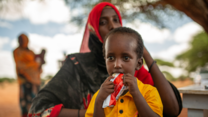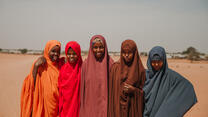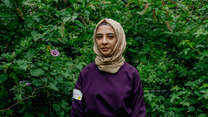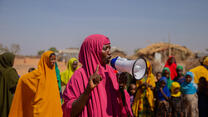Country facts
- Population: 47.2 million
- Number of refugees: 1.6 million
- Rank in Human Development Index: 166 of 191
IRC response
- Started work in Uganda: 1998
- People assisted: Over 1 million in 2023
Uganda, located in East Africa, spent decades in the grip of violent conflict before becoming host to the largest number of refugees in Africa. The IRC provides vital support to Ugandans rebuilding their lives and refugees seeking safety from ongoing conflicts in neighboring countries.
Amidst the political turmoil that saw the current government come to power in 1986, the rebel group the Lord’s Resistance Army (LRA) began terrorizing Uganda, killing tens of thousands and displacing more than 1 million people. Many Ugandans were displaced, finding comparative safety in camps that lacked food, clean water and sanitation. Thousands of children also fell victim to the war, abducted by rebel groups to serve as fighters. Following a peace agreement in 2006, Ugandans have been working to rebuild their lives and restore their communities.
Uganda has welcomed more than one million refugees from South Sudan, the Democratic Republic of Congo and Sudan. An increasing number of refugees are being hosted in Uganda’s capital, Kampala.
Uganda has some of the most progressive refugee policies of any nation. However, competition for resources, limited livelihood opportunities, and the psychosocial impacts of war contribute to increased needs amongst refugee communities. Immediate protection and legal services are needed to uphold the safety and rights of refugees in Uganda.
Despite improved health indicators, maternal and child health issues persist. Diseases, including AIDS, tuberculosis, and malaria are a leading causes of death in Uganda and have been exacerbated by a high demand on Uganda’s overburdened health care system.
Although Uganda has achieved measurable development over the past decades, the country continues to grapple with high levels of poverty, climate shocks—including drought and floods—and an overburdened public service sector.
The IRC’s mission is to help people whose lives and livelihoods are shattered by conflict and disaster to survive, recover and gain control of their future.
The IRC first began operating in Uganda in 1998, supporting the 1.8 million Ugandans displaced by the LRA insurgency. Since then, the IRC has scaled its programming across Uganda to meet the needs of a growing number of refugees seeking safety in the country. We now operate six offices across Uganda.
The IRC is supporting refugees and their host communities by:
- providing women and girls with safety, general and reproductive health, education and financial independence resources and services;
- working with families and communities to prevent violence and harmful practices, particularly against women and girls;
- helping farmers and small-business owners succeed, linking them to markets and credit for their businesses;
- teaching youth business skills, matching clients to apprenticeship opportunities and providing them with seed grants for business initiatives;
- providing vital primary health care services, medical equipment supplies and strengthening the Ugandan health care system;
- training community members to prevent, diagnose and treat common illnesses as well as to mitigate health risks, including malnutrition;
- promoting Early Childhood Development for children under five through proven learning and nurturing initiatives that aim to improve holistic learning and well-being outcomes for children and intergenerational approaches that target both children and their caretakers;
- supporting the immunization of children through the deployment of new technologies and community engagement strategies.
The IRC’s work in Uganda is more critical than ever as Ugandans remain vulnerable to disaster, disease outbreak, and as refugees continue to seek safety in the country. We pledge to put the needs of those most affected by crises, specifically women and girls, at the forefront of our efforts and to achieve measurable improvements in health, safety, education, power and economic well-being.
For a closer look at some of the work we will be doing over the next year, read the 2025 Uganda program fact sheet.





